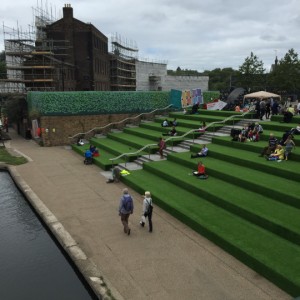 This morning after dropping my small people with their respective child-carers, I set off with a spring in my step to explore Kings Cross. This is an area I thought I knew pretty well as I used to work quite nearby and had jumped on a train up north many times.
This morning after dropping my small people with their respective child-carers, I set off with a spring in my step to explore Kings Cross. This is an area I thought I knew pretty well as I used to work quite nearby and had jumped on a train up north many times.
I realised today that in the 15 years I had lived in London, I had never ventured behind Kings Cross station. That’s because until about 4 years ago there was absolutely nothing there and…IT WAS GRIM.
This land was at one time a bustling centre of industry used as train marshalling yards, coal drops and huge areas were given over to storage of goods that would be transported from rail to barge and moved around the country.
As the need for all of these services diminished Kings Cross became an industrial wasteland. Rail took over from the canals as a transport system and the goods yards were no longer needed. The clean air act in 1956 totally did for coal and the ‘coal drops’ simply became ‘drops’. After 1945 the area became unloved and declined, eventually becoming renowned for prostitution and drug crime.
As often happens to scruffy places the cheap rents and central location attracted an artistic crowd. Anthony Gormley had a studio here and an artistic group squatted in the coach shed where they built huge industrial structures out of scrap metal. I’d imagine there were always plenty of raw materials available in the vicinity.
The arts do live on in the new Kings Cross. There is Kings Place concert hall plus Central St Martin’s college and the UAL have both relocated here. This art is more mainstream and less antisocial than its predecessors. Nothing that exists in Kings Cross now will create any controversy, no gig venue is going to be closed down because of elicit raves.
Is this a bad thing? Well I probably wouldn’t have visited had the area not changed (I was never really a Bagley’s customer) and I would certainly wouldn’t have taken my kids there. Now I’m planning a trip for the whole family, including Granny.
What struck me most on my visit was the phenomenal volume of building work. Look at a map and most of the area is still ‘under construction’. I peered into one new office building and actually saw concrete drying. It was a four year old’s dream, there were diggers and cranes galore and the further you move back from the station the more construction you find.
I also found fountains to splash in, grass to run on and a random selection of outdoor soft play items. In fact, there was lots of fun to be had for small adventurers.
So, can we call this regeneration or is it gentrification? Is the new housing affordable? Are cafes and restaurants reasonably priced?
The answer is yes and no. A glass of wine at Kings Place’s Rotunda Bar will set you back between £4 and £8, which for London is pretty average. I paid £1.50 for a coffee at the Skip Garden, which is positively cheap compared to Starbucks. Restaurants like Caravan and Dishoom are not top end but they’re not cheap either. You’ll be pushed to find fast food places in the area and the only supermarket I saw was Waitrose.
So, if you want to eat and drink you can but it will be on a slightly above average budget.
That’s where it stops, if you want to live in King Cross, it seems that you need a more than generous budget. A 3 bedroom apartment in the new Plimpsoll building is on the market for £2.9m, far beyond the means of the average Londoner earning around £35k.
I really enjoyed my trip to Kings Cross and I will be returning, the regeneration is phenomenal and yes it has been gentrified. I’d like to see more affordable accommodation to help ensure the area can remain diverse and not become a bland location housing identikit families.
Whatever, my views of the price of housing or the cost of a coffee; Kings Cross today is far better than the industrial wasteland of the 1980s.
